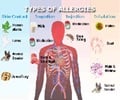Pre-schoolers can overcome peanut allergies with oral immunotherapy. Clinical outcomes will be better if they receive the treatment earlier.

‘New research suggests that oral immunotherapy can be an effective alternative to avoiding peanut allergies for a lifetime.’
Read More..




"This treatment is affordable, very safe, and highly effective, particularly if we can get the treatment going before the infant is 12 months old," said Dr. Edmond Chan, the study’s senior author at the BC Children’s Hospital Research Institute, Canada.Read More..
The study published in the Journal of Allergy and Clinical Immunology: In Practice looked at outcomes in 69 infants among a larger study group of 452 children aged five and under.
What is Oral Immunotherapy?
Oral immunotherapy is when a patient consumes small amounts of the allergenic food — in this study, peanut flour — with the dose gradually increasing to a determined maximum amount.The aim is to desensitize the child until they can have a full serving of peanut protein. But the child must continue to eat peanut products regularly long term.
Children visit a pediatric allergist in a community or hospital clinic approximately every two weeks to receive their peanut dose.
Parents gave the same daily dose between clinic visits. After 8 to 11 clinic visits, the children built `maintenance dose’ of about 1.3 grams of peanuts.
Advertisement
Four experienced beyond mild reactions, but none required epinephrine injections. Twenty did not have their peanut tolerance assessed at the end.
Advertisement
"Despite infants showing the best safety, we were still delighted with the safety of this treatment for older preschoolers. The risk of a severe reaction is much lower than it is for school-age kids," Dr. Chan noted.
"Many of the interventions we use in medicine, such as medications or surgical procedures, carry a small amount of risk that is outweighed by the benefit. I’m comfortable with the risk if well-trained allergists and clinicians perform this treatment. It’s very safe."
Results of the Study:
The treatment worked equally well for both age groups. After a year of one peanut per day, approximately 80 percent of the children had developed a tolerance for 4,000 milligrams of peanut protein in one sitting — the equivalent of roughly 15 whole peanuts.The first step in trying to prevent peanut allergies among at-risk children is to introduce them to age-appropriate, peanut-containing foods such as peanut butter or peanut flour at around six months of age.
Dr. Chan’s research suggests that oral immunotherapy can be an effective alternative to avoiding allergens for a lifetime. Avoiding allergens carries different risks, such as poor quality of life, social isolation, and anxiety.
The next step suggested by Dr. Chan’s team is to offer oral immunotherapy as early as possible after failed food allergy prevention during infancy.
Dr. Chan’s study will help inform future clinical practice guidelines and provide healthcare professionals with the information they need to recommend it for children.
Medindia












